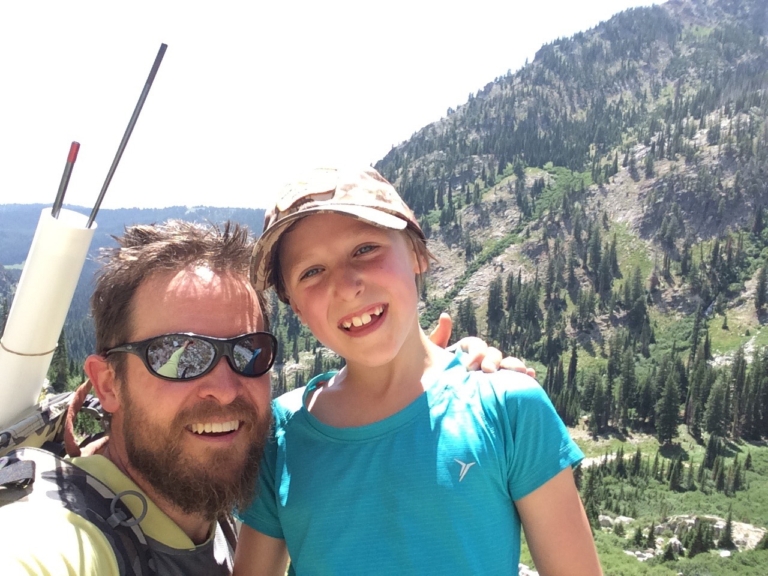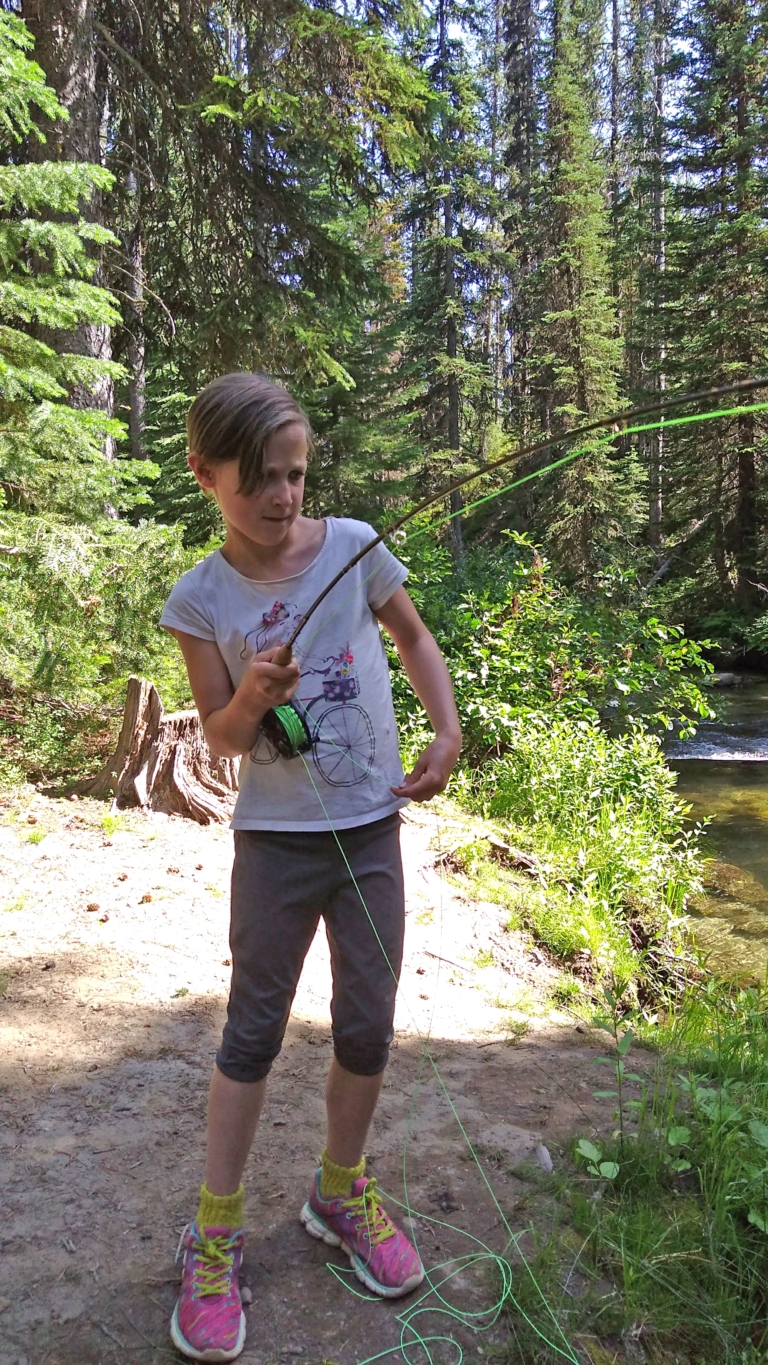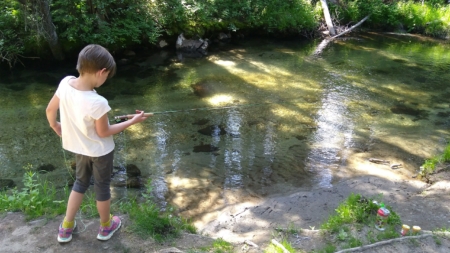When Mountains Become Islands
Are public lands still “public” when you can’t access them?
After the truck rumbled over a cattle-guard, I shut my phone off for good. Ahead loomed charcoal mountains and blue skies. Nomi, my 8-year-old daughter, swept the wisps of hair from her face and asked, “Are we going to catch fish, Dad? For sure?”
“We better,” I said. “Or we won’t have much to eat.”
We were approaching the Wallowa Mountains in the far northeast corner of Oregon. For the next week, we’d be gathering our sustenance from the meadows, mountainsides and beaver ponds of the national forest. This is a tradition in our family, a rite of passage. At 13, our daughters have their bat mitzvahs, but at 8, they learn how to feed themselves in the mountains.
The tradition is a gift handed down from my parents. At 8, I began following my father across public lands, hunting and fishing. I remember hiding from sudden thunderstorms at the base of cliffs, casting to trout doing cartwheels over caddisflies and cooking blue grouse by headlamp. Most of all, I remember reaching my strides so my boot might step on the same earth Dad had just walked.

In the midst of their father-daughter fly fishing fling in Oregon’s Wallowa Mountains, the author and his daughter get their giggles on for a mid-trail selfie. Photo: John Larison
Those childhood adventures into public wildlands proved the most inspiring, consequential experiences of my young life, and they have shaped nearly all of my decisions since. I chose to attend the University of Oregon not because of the academics but because the campus sits beside a fertile salmon stream. Upon graduation, I instinctively became a fly fishing guide, environmental educator and advocate for forests, wetlands and the rivers that feed them. Now, in our 40s, my partner and I raise our children far from pavement, where a soulful portion of each day is devoted to the chores of subsistence.
Nomi chose the shady edge of a meadow for our camp, where ponderosa and fir blanket the mountainside. As we rolled out our sleeping bags, we could smell the tang of huckleberries ripening. Nomi ran off with a bucket even before the work was done—her heart set on huckleberry pancakes. I followed along behind gathering sorrel leaves for a dinner salad.
It’s a place people have camped for millennia. The Wallowa Band of the Nez Perce—for whom the mountains are named—ventured here every summer to collect serviceberries, elderberries and huckleberries, which they dried in the hot sun and stored for winter. Nez Perce families gathered roots, greens and mushrooms; pursued the deer and elk that frequent these same summer grounds; and netted the steelhead and salmon that, at that time, still returned this far inland.
Though the rocky heart of the Wallowas was set aside as a federally protected Wilderness Area in 1940, the more fertile foothills have never been awarded such protections. They remain a quilt of private holdings, mining claims, national forest and BLM land. Each summer, cattle graze many meadows to dust, and vast stands of pine are razed by industrial logging. A few streams remain channelized and lifeless a hundred years after the gold rush.
But if you know where to look, you can still encounter the rich biodiversity that has nourished families for generations.
On our first morning, Nomi woke at dawn and asked about fishing. We scarfed down our pancakes and climbed into the truck, heading toward a small mountain stream I’ve come to cherish.
After a couple of gravel miles, we turned onto a dirt track that would deliver us to a certain plunge pool I know well—a rare piece of open water with room enough for the wayward back-casts of an 8-year-old trying to deliver her first trout fly.
The truck jacked over boulders and bounced through mud puddles. Here the spruce were growing so tightly we couldn’t see the stream, though we could hear the smash of whitewater through our open windows.
We didn’t make it far.
At a bridge over a small tributary, someone had strung a chain from pillar to pillar. The metal was so new it gleamed. Hanging from the chain was a sign that read: “NO TRESPASSING. PRIVATE PROPERTY. VIOLATORS WILL BE VENTILATED.”
I stopped the truck and stepped out. Nomi appeared at my side and took my hand. “What does trees-passing mean?”
I was as confused as my daughter. This land was public property, squarely inside the national forest—or at least I thought it was.
“Can we still fish, Dad?” Nomi asked.
“Not here, I guess. Not today.”
The dirt road was too tight to turn around, so we backed out the way we’d come, each of us watching a side-mirror to ensure I didn’t clip a tree.
After a half hour of searching, we finally found a place where a kid might be able to fish: the pool below a culvert where the gravel road crossed the stream. It was hardly a scenic location, but the pool contained trout.

How it’s done. After a few words of advice from dad, the selection of a perfect parachute Adams fly and a laser-beam cast, 8-year-old Nomi Larison hooks her first brook trout on a small stream in Oregon’s Wallowa Mountains. Photo: John Larison
We could see green shapes weaving over the pebble bottom, a mix of rainbows and smaller brook trout. In these mountains, the rainbow are genetic descendants of native steelhead who, before dams, migrated the Columbia River to the ocean and back, while the brookies are invaders originally stocked in the high-country lakes by state fisheries managers. When dinner is on the line, we target the invasives.
As my father had once done, I lifted a rock from the stream and showed Nomi the mayfly nymphs clinging to its bottom, and explained they were eating the green algae, just like elk graze a meadow. The trout, then, were like the wolves of the water.
Together, we rigged her rod and tied on a small parachute Adams. The trout were rising. All Nomi had to do was present an accurate cast—which is easier than it sounds, especially when you’re 8. Fly casting can’t be accomplished with force, only grace, and grace can’t be rushed.
To practice our casting, we went to the only open area—the road itself. We were working on stopping the rod at 10 and two when I heard a vehicle coming and guided Nomi out of the way. The truck was a white federal rig with Forest Service stickers on the sides. Its driver stopped and offered a wide smile at the little girl in pink flip-flops holding a fly rod.
“Catching any?” he called.
“Not yet,” Nomi answered. “But I’m about to.”
I took this chance to tell the federal employee about the chain I found over the bridge downstream. “Someone is trying to post public property. There’s a mile of good water down that way.”
The driver took off his sunglasses, and I saw the sympathetic face of a man who’d spent his life outdoors: deep wrinkles, sun bruises—an impenetrable air of calm. He fished a map from the papers on the bench-seat. “Show me.” I pointed out the bridge where our fishing had been thwarted that morning. He tossed the map back onto the seat beside him. “There’s about five acres of private property there, starting at the crick. Old mining claim that was bought up.”
“But isn’t the land and water beyond that five acres public property?”
“Sure is,” he said.
I asked how a private citizen could block a public road with a locked gate. “Isn’t that illegal?”
He tossed up his hands. “Bit of a grey area these days.”
I came to learn that the chained bridge we encountered that morning was part of much larger problem. Across 13 western states, gates and other barriers are being erected by landowners at staggering speed to intentionally lock the public out of public lands.
In some cases, the gates are being put up by established ranching or logging families to prevent vandalism, incursions of invasive species, or human-sparked wildfires on their lands. But many of these gates are being built by out-of-state, ultrawealthy elites who view Western wildland as a diminishing, priceless commodity. While they still can, they want to lock away as much terrain as possible for their own recreation, usually trophy hunting.
According to The New York Times, as of 2019, just 100 American families owned about 42 million acres in the West, a 50 percent increase from 2007. The most sought-after parcels are those that cut off access to the public lands beyond them, because by buying up the private ground, the new owners essentially get the public land for free.
The Theodore Roosevelt Conservation Partnership, a nonprofit that works to safeguard access to fish and wildlife habitat, has determined that more than 16 million acres of our state and federal lands in the West have become islands within oceans of private property. In theory you can still access these lands—if you own a helicopter and can obtain the permit needed to land it.
One of the most blatant land-grabbers is the Texas-based Wilks family, who built a multibillion-dollar fracking business and have used their wealth to not only buy up private lands that border public holdings but also to employ armed guards to patrol their properties.
In some cases—like when the road in question was historically built by a landowner—gates can legally be erected, despite a resulting loss of access to public land. But in many cases, the gates clearly violate state or even federal laws, yet the scope of the problem limits enforcement. According to High Country News, one illegal gate blocking access to the Beaverhead-Deerlodge National Forest remained in place for more than 30 years before officials finally ordered it removed.
The damage inflicted by illegal gates is especially pronounced in those national forests that have limited points of access. Montana’s Crazy Mountains might be the most extreme example. The entire 35-mile eastern front has only one accessible trailhead left. The Forest Service itself admits that 80 percent of the Crazies are now functionally inaccessible to the public.
The chained bridge Nomi and I encountered that morning left me thinking about what’s lost when public land is locked away.
My days exploring public wildlands as a kid were, in effect, a bridge to the realization that human beings have a responsibility to function as humble stewards of their ecological community. Who would I have become without those opportunities?
Nomi is now 11. Last November we worked together to build a blind of fir boughs beside a game trail, where we huddled in wait each afternoon. When a flock of wild turkeys finally strutted past, Nomi used her great-grandfather’s shotgun to harvest the family’s Thanksgiving meal. This spring she’s eager to celebrate her birthday by taking a road trip in search of morels. She meets any chance to find or catch wild food with bright eyes and a beaming smile. This passion began for each of us on a small, publicly owned stream when we were 8 years old.
After practicing her fly cast that summer day in the Wallowas, Nomi and I waded together across a riffle. The rocks were slippery, but we kept our balance by walking arm-in-arm.
Her first three casts snagged tree limbs behind us, and each time I crawled up the bank to free her fly.
“Sorry, Dad.”
“Don’t worry,” I told her. “Papa did the same for me.”
On her fourth cast, the fly landed perfectly ahead of the trout, and we watched together as a snout broke the surface. She fought the fish to hand, and that night we ate the brookie and several others smoked over a cedar plank while coyotes howled in the distance.
Nomi leaned close and said, “When I grow up, I’m gonna bring my kids here too.”
“Good,” I told her. And then I thought, Hopefully you won’t need bolt cutters to reach the place.

